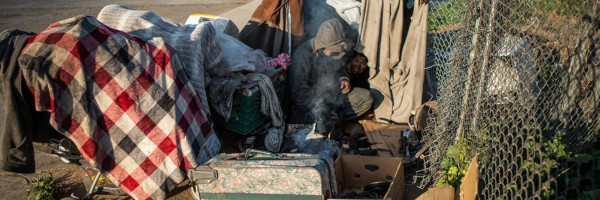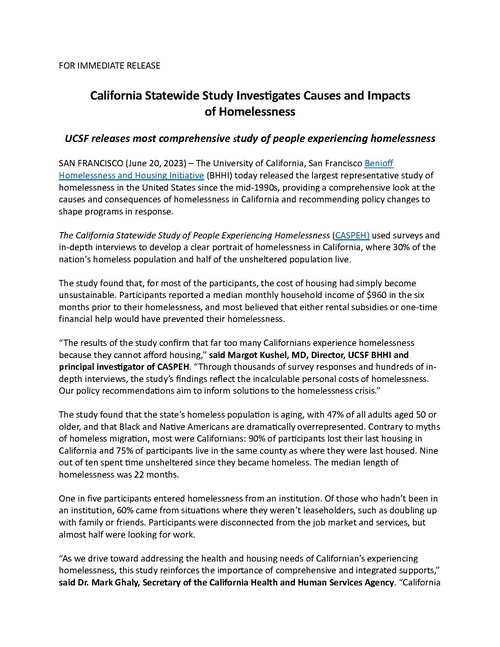California Statewide Study Investigates Causes and Impacts of Homelessness
| News | |
| Image | 
|
|---|---|
| Published | 2023-06-20 |
| Point(s) of Contact | Margot Kushel |
| Organization(s) | University of California |
| Where | San Francisco |
| Display | Yes |

| |
The University of California, San Francisco Benioff Homelessness and Housing Initiative (BHHI) today released the largest representative study of homelessness in the United States since the mid-1990s, providing a comprehensive look at the causes and consequences of homelessness in California and recommending policy changes to shape programs in response.
The California Statewide Study of People Experiencing Homelessness (CASPEH) used surveys and in-depth interviews to develop a clear portrait of homelessness in California, where 30% of the nation’s homeless population and half of the unsheltered population live.
The study found that, for most of the participants, the cost of housing had simply become unsustainable. Participants reported a median monthly household income of $960 in the six months prior to their homelessness, and most believed that either rental subsidies or one-time financial help would have prevented their homelessness.
“The results of the study confirm that far too many Californians experience homelessness because they cannot afford housing,” said Margot Kushel, MD, Director, UCSF BHHI and principal inves=gator of CASPEH. “Through thousands of survey responses and hundreds of indepth interviews, the study’s findings reflect the incalculable personal costs of homelessness.
Our policy recommendations aim to inform solutions to the homelessness crisis.” The study found that the state’s homeless population is aging, with 47% of all adults aged 50 or older, and that Black and Native Americans are dramatically overrepresented. Contrary to myths of homeless migration, most were Californians: 90% of participants lost their last housing in California and 75% of participants live in the same county as where they were last housed. Nine out of ten spent time unsheltered since they became homeless. The median length of homelessness was 22 months.
One in five participants entered homelessness from an institution. Of those who hadn’t been in an institution, 60% came from situations where they weren’t leaseholders, such as doubling up with family or friends. Participants were disconnected from the job market and services, but almost half were looking for work.
“As we drive toward addressing the health and housing needs of Californian’s experiencing homelessness, this study reinforces the importance of comprehensive and integrated supports,” said Dr. Mark Ghaly, Secretary of the California Health and Human Services Agency. “California is taking bold steps to address unmet needs for physical and behavioral health services, to create a range of housing options that are safe and stable, and to meet people where they are at. We are grateful for the voices of those who participated in this study, as they will help guide our approach.”
Participants had experienced multiple forms of trauma throughout their life, increasing their vulnerability to homelessness and contributing to their mental health and substance use challenges. Two-thirds reported current mental health symptoms and more than a third experienced physical or sexual violence during this episode of homelessness. More than a third had visited an Emergency Department in the prior six months. One in five who used substances reported that they wanted substance use treatment—but couldn’t get it.
“Having experienced homelessness firsthand, I vividly recall the relentless fight for survival, the pervasive shame that haunted me, and my unsuccessful endeavors to overcome homelessness on my own,” said Claudine Sipili, a member of the CASPEH Lived Exper=se Board. “The study holds great significance for me because it aims to provide a more comprehensive understanding of homelessness. I hope it will inform the development of effective strategies, policies, and programs; address the issue in a dignifying way; and support individuals in their transition from homelessness to housing stability.”
Based on the CASPEH findings, BHHI offers six key policy recommendations: • Increase access to housing affordable to extremely low-income households making less than 30% of the Area Median Income: (1) produce more housing affordable to the lowest-income renters; (2) expand rental subsidies (e.g., Housing Choice Vouchers); and (3) ease use of subsidies (e.g., increase housing navigation services, create and enforce anti-discrimination laws). • Expand targeted homelessness prevention, such as financial supports and legal assistance at, (1) places where people receive other services, including social service agencies, healthcare settings, domestic violence services, and community organizations; and (2) institutional exits (jails, prisons, drug treatment). Expand and strengthen eviction protections.
- Provide robust supports to match the behavioral health needs of the population, by (1) increasing access to low barrier mental health, substance use, and harm reduction services during episodes of homelessness; and (2) staffing permanent supportive housing with evidence-based models, such as pathways to housing, assertive community treatment, and intensive case management.
- Increase household incomes through evidence-based employment supports such as training, support for job search and transportation, and provide outreach *Increase outreach and service delivery to people experiencing unsheltered homelessness.
• Embed a racial equity approach in all aspects of homeless system service delivery.
About CASPEH
CASPEH was designed to be representative of all adults 18 years and older experiencing homelessness in California. It includes nearly 3,200 administered questionnaires and 365 indepth interviews with adults experiencing homelessness in eight regions of the state, representing urban, rural, and suburban areas. Interviews were conducted in English and Spanish, with interpreters for other languages. In partnership with a wide array of community stakeholders, the UCSF BHHI team collected data between October 2021 and November 2022. See additional information, including the full report and executive summary, here. Community advisory boards consisting of those with lived experiences of homelessness and those involved in policy and practice played a critical role at every stage of the study. CASPEH was funded by the UCSF Benioff Homelessness and Housing Initiative, the California Health Care Foundation, and Blue Shield of California Foundation. A documentary project produced in support of CASPEH, which includes photographs and interviews with Californians experiencing homelessness, is available at www.unhousedca.com.
Media Contact: For more information or to schedule an interview with Margot Kushel, MD, UCSF BHHI Director, or members of the Lived Expertise Advisory Board, please contact Beth Weaver at BHHImedia@ucsf.edu or 301-814-4088.
About UCSF BHHI
The UCSF Benioff Homelessness and Housing Initiative provides accurate, timely policy-oriented research about homelessness for local, state, and national policymakers and practitioners. Funded by a generous gio from Marc and Lynne Benioff and based at the UCSF Center for Vulnerable Populations, UCSF BHHI is a trusted source for evidence-based practice, policy, and scalable solutions—turning evidence into action to prevent and end homelessness.